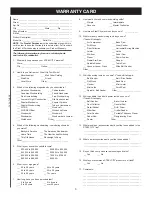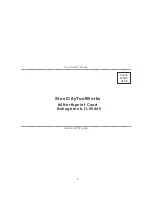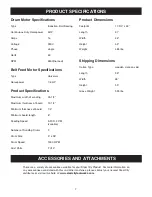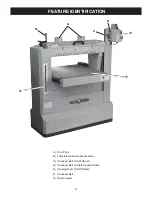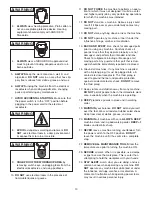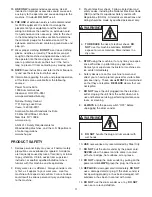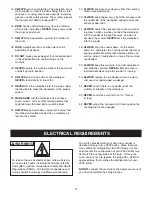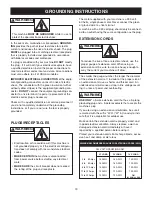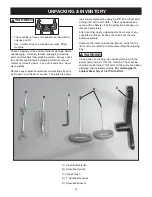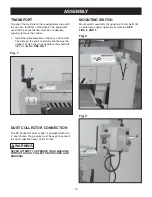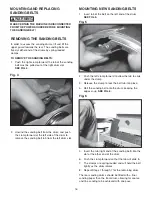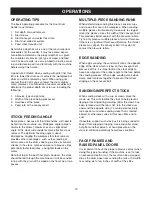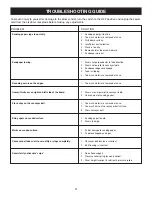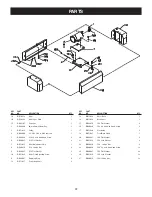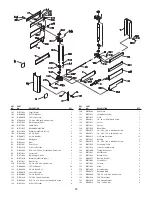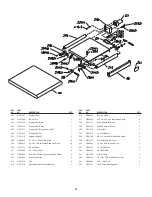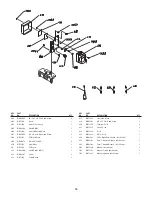
19
OPERATIONS
OPERATING TIPS
The basic operating procedure for the Dual Drum
Sander is as follows:
1.
Set depth of wood removal.
2.
Start drums.
3.
Start conveyor and select feed rate.
4.
Start dust collector system.
5.
Feed stock through unit.
Determining depth of cut is one of the most important
procedures for the sander. It may take some experi-
mentation to determine the proper depth of cut, given
the variables of abrasive grit, type of wood, and feed
rate. For best results, use scrap wood to practice sand-
ing and to develop skill and familiarity with the machine
before doing finish work.
A good rule of thumb when sanding with grits finer than
80 is to lower the drum so it contacts the workpiece but
drum can still be rotated by hand. When using grits
coarser than 80 grit, you can lower the drum slightly
more. However, a combination of several variables will
determine the proper depth of cut to use, including the
following:
1.
Abrasive type and grit size.
2.
Width of the piece being processed.
3.
Hardness of the piece.
4.
Feed rate of the conveyor belt.
STOCK FEEDING ANGLE
Some pieces, because of their dimensions, will need to
be fed into the machine at a 90-degree angle (perpen-
dicular to the drums). However, even a slight offset
angle of the stock will provide for more effective stock
removal. The optimum feeding angle is about
60-degrees. Angling the workpiece for stock removal
provides other advantages, such as less loading of
certain areas of the drums due to glue lines or mineral
streaks in the stock, more even wear of abrasive strips,
potentially faster feed rates, and lighter loads on the
motor.
Note that to get the best final finish, however, the stock
should be fed through the machine so it will be sanded
in line with the grain of the wood on the final one or two
passes.
MULTIPLE-PIECE SANDING RUNS
When determining sanding thickness, consider cups
and crowns that are in the workpiece. When sanding
multiple pieces simultaneously, make sure to stagger
(step) the pieces across the width of the conveyor belt.
This produces better contact with the pressure rollers.
Try to only process multiple pieces of similar thickness.
If there is a significant thickness difference, the thinner
pieces may slip on the conveyor belt if they do not
contact the pressure rollers.
EDGE SANDING
When edge sanding, the sander will mimic the opposite
edge of the stock which is lying on the conveyor belt.
Because of this, it is important for the stock edge to
have been ripped at the proper angle to the face before
the sanding process. When edge sanding small stock,
clamp several pieces together to prevent them from
slipping on the conveyor belt.
SANDING IMPERFECT STOCK
When sanding stock with a cup or crown, place the
crown up. This will stabilize the stock to help prevent
tipping or rocking during sanding. (After the crown has
been removed and the top is flat, turn the stock over
and sand the opposite side.) To avoid personal injury,
take special care when sanding stock that is twisted,
bowed, or otherwise varies in thickness from end to
end.
If possible, support such stock as it is being sanded to
keep it from slipping or tipping. Use extra roller stand,
help from another person, or hand pressure on the
stock to minimize potentially hazardous situations.
FACE FRAMES AND
RAISED PANEL DOORS
It is important to have the proper abrasive contact when
doing this type of sanding. If the machine is set to take
an excessive depth of cut, the result can be a gouge or
dip as the drum goes from sanding the rails at full width
to sanding just a few inches of width of the stiles.
Summary of Contents for 55220
Page 28: ......

